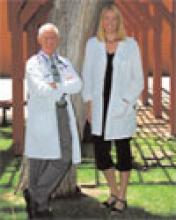VTE Studies Win Grants
Two pharmacist-hospitalist teams each won $50,000 grants June 12 from the American Society of Health-System Pharmacists (ASHP) Research and Education Foundation (Bethesda, Md.) to support development of screening tools and order sets to prevent and treat hospital-acquired venous thromboembolism (VTE).
The grant winners and lead co-investigators from each team:
- Robert Weibert, PharmD, health sciences clinical professor and director of the Anticoagulation Clinic, School of Pharmacy, and Gregory Maynard, MD, MS, head of the Division of Hospital Medicine and associate clinical professor of medicine at the University of California-San Diego (UCSD); and
- Rachel Hroncich, PharmD, pharmacy clinical coordinator of Presbyterian Healthcare Service, and Randle Adair, DO, PhD, a PMG hospitalist in adult medicine from Albuquerque, N.M.
The ASHP, a nonprofit organization, fosters safe medication use.
“We are thrilled that our grant application was selected by the ASHP and excited about the opportunity for our research to improve patient care,” says Dr. Hroncich.
The ASHP Research and Education Foundation grant program, sponsored by Sanofi-Aventis, supports research by hospitalists and hospital pharmacists to treat VTE, with a focus on hospitalized patients and post-discharge follow-up. The grants are geared to help hospitalists and pharmacists reduce hospital-acquired VTE, a significant cause of morbidity and mortality in hospitals.
VTE-related treatment costs $1.5 billion a year, according to researchers at the University of Washington School of Pharmacy in Seattle. ASHP statistics indicate VTE affects more than 450,000 hospitalized patients annually. The condition—an amalgam of deep vein thrombosis (DVT) and pulmonary embolism (PE)—affects a range of hospitalized patients. Gynecologic, orthopedic, urologic, vascular, trauma, and cancer patients all are at risk—as are those with other medical conditions such as congestive heart failure, severe respiratory disease, and obesity, or those who are bedridden.
The ASHP grants help pharmacist-hospitalist teams find tools to screen for VTE. Such tools let clinicians intervene early with at-risk patients. Better screening and intervention requires sound clinical, administrative, and IT processes.
The trick is to encourage busy hospitalists to use a consensus-based VTE screening tool for all hospitalized patients.

Rachel Hroncich, PharmD, pharmacy clinical coordinator of Presbyterian Healthcare Service, and Randle Adair, DO, PhD, a PMG hospitalist in adult medicine from Albuquerque, N.M.
Rachel Hroncich, PharmD, pharmacy clinical coordinator of Presbyterian Healthcare Service, and Randle Adair, DO, PhD, a PMG hospitalist in adult medicine from Albuquerque, N.M.
While most VTE research involves retrospective chart review of diagnostic codes, Drs. Weibert and Maynard’s grant research goes beyond such studies by identifying patients at risk concurrent with their hospitalizations. Dr. Maynard says the need is urgent: “Hospitals grossly underestimate the risk of VTE. In a 300-bed hospital, at least 150 patients are at risk of hospital-acquired VTE at any time.”
The UCSD team hopes to improve VTE screening by integrating an order set into the hospital’s computer physician order entry (CPOE) system. “The literature points to a bundle of best practices for VTE,” says Dr. Maynard, “including baseline lab work, use of compression stockings, using heparin for an optimal time period, patient education for those on anticoagulants, timely follow-up post discharge, the Society of Hospital Medicine collaborative, etc.”



